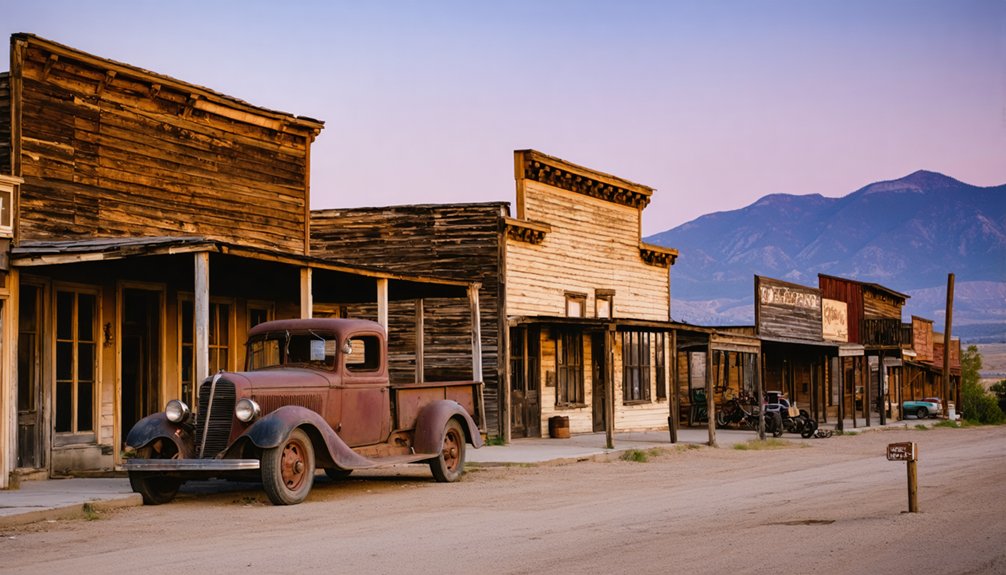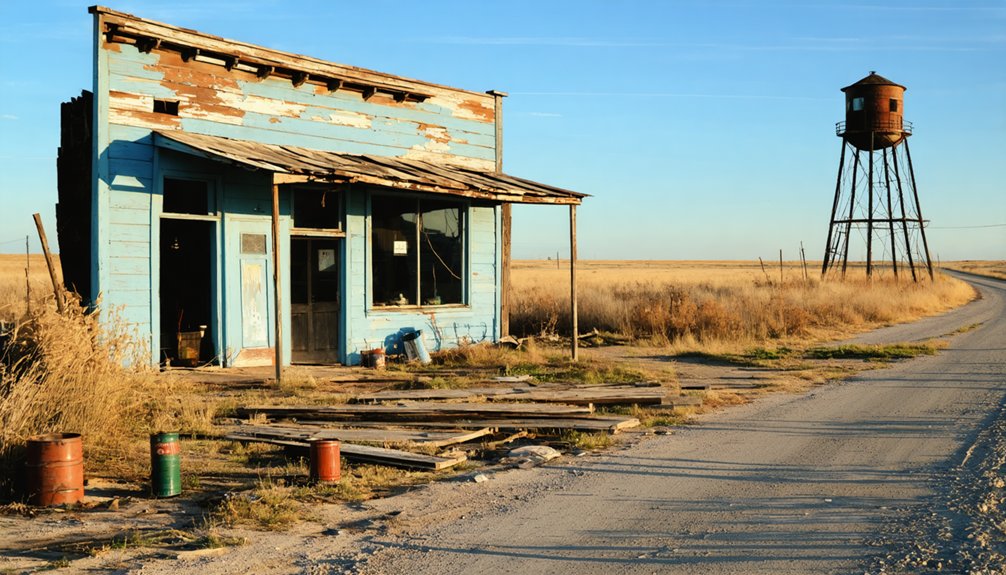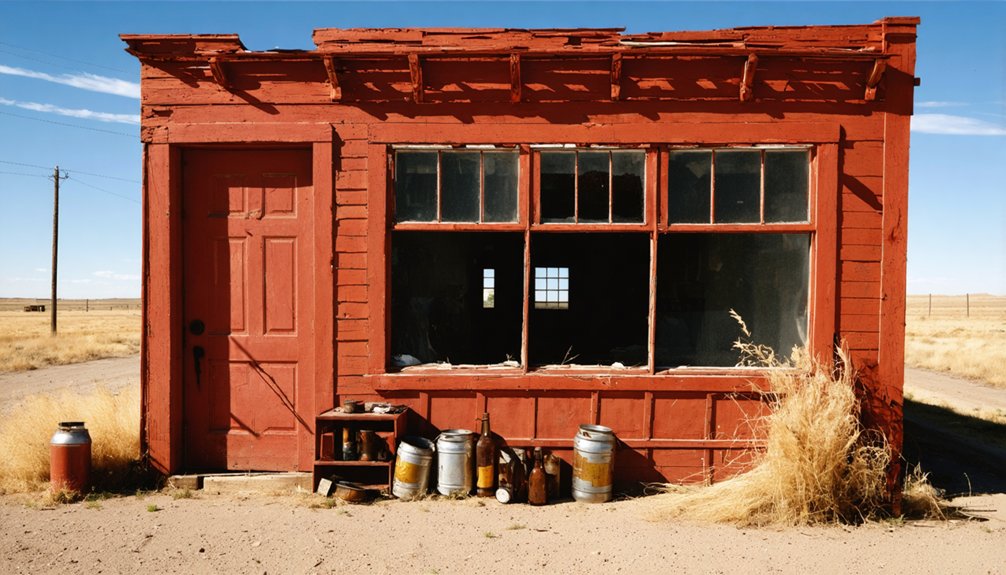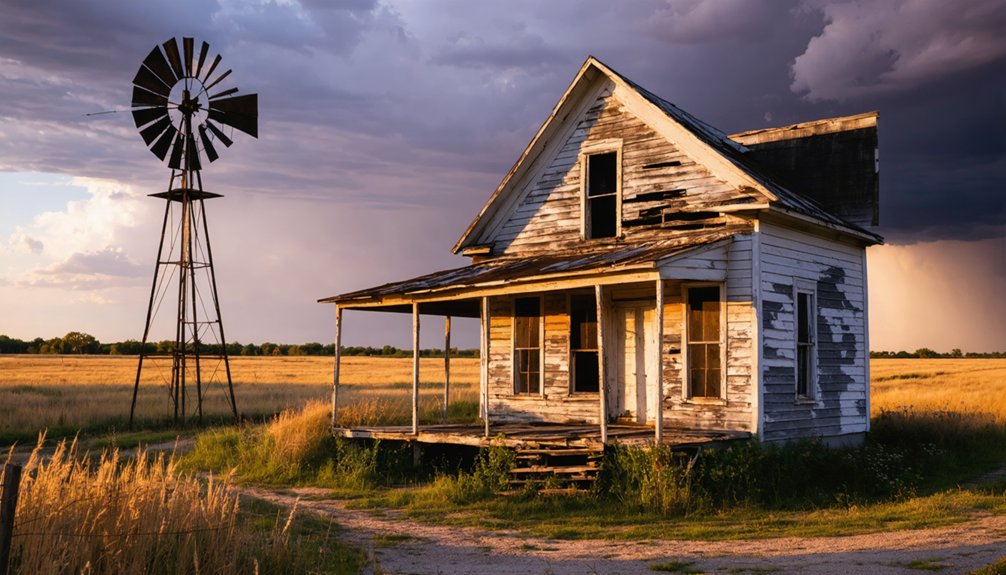You’ll find Pedro nestled in South Dakota’s Black Hills, where it thrived as a mining settlement in the early 1900s with over 300 residents. The town featured essential services, including the Pedro Bugle newspaper managed by Carrie Ingalls. After facing economic challenges and population decline, a devastating tornado in 2003 destroyed most remaining structures. Today, Pedro’s ruins and historical records, preserved by the South Dakota State Historical Society, tell a fascinating tale of boom-and-bust frontier life.
Key Takeaways
- Pedro was a Black Hills mining town established during the 1874 gold rush that later became abandoned due to economic decline.
- The town reached its peak in the early 1900s with 300 residents and featured general stores, post offices, and saloons.
- Carrie Ingalls managed the town’s newspaper, The Pedro Bugle, which served as the community’s primary news source.
- A devastating tornado in 2003 destroyed most of Pedro’s remaining structures, accelerating its ghost town status.
- The town’s historical records and photographs are preserved by the South Dakota State Historical Society for research and documentation.
The Birth of a Black Hills Settlement

While the Black Hills had been home to Native American tribes for millennia, particularly the Lakota who named it Pahá Sápa and considered it sacred, the region’s transformation into a settlement frontier began with the 1874 discovery of gold during Custer’s expedition.
The settlement dynamics shifted dramatically after Congress seized the land in 1877, breaking the Fort Laramie Treaties of 1851 and 1868.
You’ll find that this indigenous displacement led to rapid changes as miners and entrepreneurs flooded the region, establishing towns like Pedro amid the gold rush fever.
What had been protected Native territory, inhabited by various tribes including the Arikara, Cheyenne, and Lakota since 1500 AD, quickly transformed into a bustling frontier of mining camps and settlements.
The dark, forested landscape of ponderosa pine forests created the distinctive appearance that gave the Black Hills their name.
This transformation was enabled by the government’s “sell or starve” policy that forced the Sioux to relinquish their lands through the Act of 1877.
Life in Early Pedro
As settlers established themselves in Pedro during the late 1800s, daily life centered around subsistence farming and livestock raising, with families working together to build sturdy log cabins from local timber.
You’d find extended families supporting each other through harsh winters and unpredictable weather, sharing resources and labor to survive. The region’s extreme temperatures made survival especially challenging during winter months.
Community traditions emerged through religious gatherings and seasonal celebrations, where you’d experience storytelling, music, and dance in multi-purpose buildings.
Economic challenges like crop failures and limited trade options tested settlers’ resilience. Local general stores and traders, common throughout South Dakota in the 1830s, became vital hubs for exchanging goods and information.
You’d rely on hunting, fishing, and foraging to supplement your diet while dealing with isolation and basic infrastructure.
Despite these hardships, the community grew to include general stores, blacksmith shops, and small schools, creating a network of support that helped residents adapt to frontier life.
The Pedro Bugle and Carrie Ingalls
Beyond the day-to-day struggles of frontier life, Pedro’s growing community found its voice through the Pedro Bugle newspaper in the early 20th century.
The name Pedro, meaning son of stone, reflected the resilient nature of the frontier town and its inhabitants.
Under E.L. Senn’s ownership, the publication became a crucial source of local news for the town’s 300 residents.
Carrie Ingalls’ influence on the paper began when she took over its management, marking the start of her remarkable journalism career.
Like the later Milwaukee-based Bugle newspaper, this small frontier publication faced many challenges while serving its community.
You’ll find that Carrie’s newspaper management skills developed markedly during her time at the Pedro Bugle.
Her success led to opportunities at other publications, including the Roseland Review in 1910 and later the Keystone Recorder.
While the Pedro Bugle eventually ceased publication as the town declined into a ghost town, its legacy lives on through South Dakota’s historical archives, documenting an important chapter in the state’s frontier journalism.
Daily Commerce and Community
During Pedro’s peak years in the early 1900s, the town bustled with over 300 miners and diverse commerce that served the Black Hills Gold Rush.
You’d find essential services like general stores, post offices, and saloons where miners, families, and transient workers gathered for both business and socializing. Similar to other ghost towns like Trojan, tourism disrupted residents who remained after the town’s decline.
The town’s commerce challenges intensified as transportation methods evolved. While stagecoach lines and railroads initially supported the flow of supplies and minerals, newer routes often bypassed Pedro. Like many communities, Pedro’s economy struggled when trucking replaced railroads for shipping goods.
Community cohesion depended heavily on mining’s sustainability and local institutions like schools and churches. As mining yields declined, many residents relocated to more prosperous nearby towns.
Some dedicated business owners stayed behind as community anchors, but Pedro’s economy couldn’t escape the boom-bust cycle that plagued many Black Hills mining towns.
Notable Buildings and Structures
While records of Pedro’s original structures remain scarce, historical photographs reveal the town’s architectural character through simple log buildings with distinctive sod roofs.
You’ll find these notable structures were built using locally sourced timber from the Black Hills, perfectly adapted to the region’s harsh climate. The sod roofs provided essential insulation against both summer heat and winter cold.
The town’s architectural styles were primarily functional, featuring single-story log cabins that served as homes, businesses, and community gathering spaces. Like many sites in disrepair, Pedro’s buildings gradually succumbed to abandonment and decay. Similar to Cottonwood’s former bank building, the town once had financial institutions serving the local community.
You won’t find any grand public buildings or specialized structures today – most have vanished completely. What’s left are challenging-to-locate foundations and footings, now largely reclaimed by nature.
Post and wire fencing remnants suggest where settlers once kept their livestock and marked their property boundaries.
Geographic Features and Location
Located at coordinates 44°25′12″N 102°07′08″W in Pennington County’s unorganized territory, Pedro stands as a symbol of South Dakota’s frontier past.
You’ll find this ghost town positioned where the Great Plains meet the Black Hills region, characterized by rolling grasslands and proximity to the Badlands formations. The site’s geographic isolation and challenging terrain characteristics contributed to its eventual abandonment.
- Area features semi-arid climate with extreme temperature variations
- No major water bodies nearby, limiting historical settlement potential
- Terrain shifts from plains to more rugged topography
- Access requires off-road navigation through undeveloped grasslands
- Natural reclamation has returned the land to its original state
The site’s remote location, far from modern highways and infrastructure, reflects the challenges that faced many frontier settlements in this unforgiving landscape.
The Decline Years

As railroads gave way to highways and rural populations shifted toward urban centers, Pedro’s decline accelerated through the mid-20th century.
Population migration patterns saw younger residents leaving for better urban opportunities, while economic shifts hit local businesses hard. The general store closed, and agricultural consolidation reduced the number of nearby ranches needing supplies.
You’ll find Pedro’s infrastructure deteriorated as tax revenues dwindled. The schoolhouse closed through consolidation, and road maintenance became sporadic.
By the early 2000s, the town was barely hanging on when a devastating tornado struck on June 24, 2003. This natural disaster destroyed most remaining structures, effectively ending Pedro’s existence as a community.
Today, the site is classified as “barren,” with only scattered foundations hinting at its past.
Pedro’s Legacy Today
Despite its physical decline, Pedro maintains a lasting cultural footprint through several distinctive elements of its past.
You’ll find its enduring influence in ghost town tourism circles, where explorers can still view the remnants of the former motel and church. The town’s connection to Carrie Ingalls and the Pedro Bugle newspaper has preserved its place in American frontier history, while its unique name origin from a card game adds to its cultural heritage appeal.
- The town serves as a case study for boom-bust cycles in South Dakota’s settlement history
- Its remains attract history enthusiasts and ghost town explorers
- The Pedro Bugle represents early rural journalism in the American frontier
- Its proximity to the Badlands creates opportunities for combined heritage tourism
- Local historical societies continue preserving Pedro’s story within regional narratives
Preserving Pedro’s Memory

You’ll discover Pedro’s rich history through the carefully preserved documents at the South Dakota State Historical Society, including town records, census data, and copies of the *Pedro Bugle* newspaper.
Historic photographs capture glimpses of daily life when Pedro’s population peaked at 300 residents. The visual documentation, along with Will G. Robinson’s detailed ghost town files at the South Dakota State Museum, helps you understand Pedro’s transformation from a bustling Black Hills community to a representation of the region’s past.
Historical Records Matter
While ghost towns often fade into obscurity, Pedro’s historical records paint a vivid picture of a once-thriving South Dakota community.
Through careful record preservation and historical documentation, you’ll discover a town that once supported 300 residents and its own newspaper, the Pedro Bugle. These archives reveal how the community chose its unique name during a card game and chronicle daily life in Pennington County.
- The Pedro Bugle serves as a time capsule of local news and community events
- County records preserve vital demographic and administrative details
- Private collections, including Will G. Robinson’s archives, offer personal perspectives
- State Historical Society maintains significant documents about Pedro’s development
- Community histories capture social dynamics and cultural traditions
These preserved records don’t just tell Pedro’s story – they help you understand South Dakota’s rich heritage and the forces that shaped its communities.
Photographs Tell Stories
Beyond the written records, Pedro’s photographic legacy brings its ghost town story into sharp focus. Through photographic storytelling, you’ll discover the profound transformation of this South Dakota settlement – from bustling community to silent ruins.
Each image captures fleeting moments: abandoned interiors, weathered storefronts, and empty grain elevators that once anchored local commerce. The emotional resonance of these photographs reveals more than mere architectural decay.
You’ll find evidence of lives suddenly interrupted in the personal items left behind, while seasonal changes documented through the years show nature steadily reclaiming human spaces. Despite restricted access to many sites today, professional and amateur photographers have preserved Pedro’s visual history, transforming its ruins into lasting monuments of regional identity.
Frequently Asked Questions
Were Any Notable Crimes or Outlaws Associated With Pedro?
You won’t find any notable outlaws or documented crime history in Pedro’s records. Unlike other Black Hills towns known for lawlessness, this small settlement maintained a peaceful reputation throughout its existence.
What Happened to the Residents When Pedro Was Abandoned?
You won’t find clear records showing where Pedro’s residents went. Based on typical migration patterns in South Dakota’s history, they likely scattered to larger towns and cities seeking better economic opportunities.
Did Pedro Have Its Own Cemetery, and Does It Still Exist?
You’ll find it’s unclear whether those who passed on in Pedro had their own designated cemetery location. While burial practices were common in Black Hills ghost towns, no confirmed records exist of Pedro’s cemetery.
What Natural Disasters or Severe Weather Events Impacted Pedro’s History?
You’ll find flood damage and drought impact were likely significant, though no direct records exist. The town faced typical Black Hills challenges: harsh winters, flash floods, and severe thunderstorms.
Were There Any Native American Settlements or Conflicts Near Pedro?
You’ll find the Arikara were first to settle near Pedro, followed by Sioux tribes who displaced them. Native American conflicts intensified during westward expansion, leading to broken treaties and forced relocations.
References
- https://en.wikipedia.org/wiki/Pedro
- https://www.youtube.com/watch?v=_0WNYsFLSLA
- https://www.sdhspress.com/journal/south-dakota-history-2-2/some-black-hills-ghost-towns-and-their-origins/vol-02-no-2-some-black-hills-ghost-towns-and-their-origins.pdf
- https://www.sdpb.org/rural-life-and-history/2023-08-21/some-black-hills-ghost-towns-and-their-origins
- https://www.powderhouselodge.com/black-hills-attractions/fun-attractions/ghost-towns-of-western-south-dakota/
- https://www.blackhillsbadlands.com/blog/post/old-west-legends-mines-ghost-towns-route-reimagined/
- https://icatchshadows.com/okaton-and-cottonwood-a-photographic-visit-to-two-south-dakota-ghost-towns/
- https://en.wikipedia.org/wiki/List_of_ghost_towns_in_South_Dakota
- https://sddigitalarchives.contentdm.oclc.org/digital/collection/photos/id/12661/
- https://en.wikipedia.org/wiki/Seizure_of_the_Black_Hills



